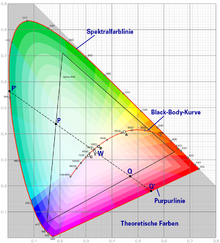Purple line
The purple line , also known as the purple line, is the line that connects the two outermost points of the spectral color spectrum on the CIE standard valence table in such a way that the projection of the color body is closed. It lies between the short-wave violet and the long-wave red.
description
The purple line is a theoretical construction from the mathematical description of human color perception , which is based on the three color receptors for daytime vision , normalized to the standard observer . The purple line is that set of maximally saturated color valences that a person with normal vision can perceive and distinguish, but which does not belong to the set of spectral colors . The colors of the purple line are a result of color perception.

A thought experiment to clarify the cause
If visible radiation is broken down into the spectrum and these color stimuli are viewed one after the other from long-wave (from 780 nm) to short-wave (up to 380 nm), different receptors in the eye react. First the red-sensitive L-cones are excited. In addition, the cones for red vision and those for green vision are stimulated. Corresponding color valences arise one after the other and yellow-red, orange, red-yellow and yellow tones are seen. The M-cones react for green vision and, increasingly, the S-cones react to cyan stimulation for blue vision. Even shorter-wave radiation (high-energy photons) (UV-A) no longer trigger a color stimulus, as there are no receptors for it. Short-wave UV radiation is intercepted by the lens and the glass body. From long-wave to short-wave light, all three types of cones are excited one after the other.
There is no (single) spectral color that evokes a color stimulus in purple. However, mixed colors can stimulate the wavelength-sensitive S and L cones in both the blue and red areas. Such mixed colors and not actual spectral colors are the everyday color stimuli of light colors and body colors . These purple tones have both long-wave and short-wave spectral components. Color valences arise that are perceived as red-violet or blue-violet mixed colors. These mixed colors are shown on the purple line. Magenta or the eponymous purple , modern pink and elderly purple are also part of it.
Representation by the color wheel
A “didactic” idea of the purple line is clear from the color wheel . Here both ends of the spectrum are brought together and the colors “blurred” to close the circle. This results in a closed line, in the simplest case a circle, in other color models it is more complicated curves. The colors necessary to close the circle are the colors of the purple line. The CIE diagram is therefore a more precise representation of the color wheel. The respective shape depends on the requirements that the respective model should meet. The basis of color measurement, on the other hand, has so far been the physical color stimulus of the spectrum, since color perception has not yet been able to be measured directly.
Individual evidence
- ↑ In the standard valence table on the curved boundary line: Spectral color train. The straight line below is occupied by the purple line. Spectral color gradient : from left short-wave to right long-wave light. Beyond these limits, humans have no receptors.

